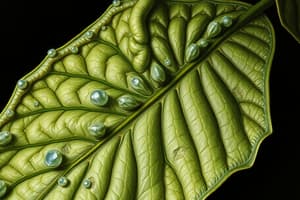Podcast
Questions and Answers
What is the primary function of meristematic tissue in plants?
What is the primary function of meristematic tissue in plants?
- Storage of nutrients and water
- Protection against pathogens
- Production of new cells (correct)
- Photosynthesis
Which type of meristem specifically leads to the increase in length of stems and roots?
Which type of meristem specifically leads to the increase in length of stems and roots?
- Lateral meristem
- Apical meristem (correct)
- Vascular cambium
- Intercalary meristem
What process allows a differentiated cell to revert to a meristematic state?
What process allows a differentiated cell to revert to a meristematic state?
- Mitosis
- Dedifferentiation (correct)
- Differentiation
- Cell elongation
Which type of permanent tissue consists of only one kind of cell?
Which type of permanent tissue consists of only one kind of cell?
Which of the following cells are responsible for controlling gas exchange in plants?
Which of the following cells are responsible for controlling gas exchange in plants?
What is the main role of parenchyma tissue in plants?
What is the main role of parenchyma tissue in plants?
What is cutin and its primary function in plant tissues?
What is cutin and its primary function in plant tissues?
Which of the following types of meristem is not typically found in monocot plants?
Which of the following types of meristem is not typically found in monocot plants?
Which cell type in collenchyma provides flexible support due to its unevenly thickened walls?
Which cell type in collenchyma provides flexible support due to its unevenly thickened walls?
What is the primary function of sclerenchyma tissue?
What is the primary function of sclerenchyma tissue?
Which type of xylem conducting cell is characterized by being wider and more efficient in transporting water than tracheids?
Which type of xylem conducting cell is characterized by being wider and more efficient in transporting water than tracheids?
What component of phloem acts as a sieve plate, facilitating the flow of nutrients?
What component of phloem acts as a sieve plate, facilitating the flow of nutrients?
Which of the following correctly describes the root system of a plant?
Which of the following correctly describes the root system of a plant?
Which structure serves as the embryonic root in a germinating seed?
Which structure serves as the embryonic root in a germinating seed?
What term is used to describe the contents transported by xylem and phloem?
What term is used to describe the contents transported by xylem and phloem?
Which type of shoot is defined as having leaves, but no reproductive structures?
Which type of shoot is defined as having leaves, but no reproductive structures?
What does the vascular cambium primarily produce?
What does the vascular cambium primarily produce?
What is heartwood?
What is heartwood?
Which modified stem is responsible for food storage underground?
Which modified stem is responsible for food storage underground?
Which part of the leaf is primarily involved in gas exchange?
Which part of the leaf is primarily involved in gas exchange?
What issue is mitigated by the epidermis of the leaf?
What issue is mitigated by the epidermis of the leaf?
How are the veins arranged in monocots?
How are the veins arranged in monocots?
What primary function is associated with guard cells?
What primary function is associated with guard cells?
During leaf development, what do leaf primordia emerge from?
During leaf development, what do leaf primordia emerge from?
Which hormone is primarily associated with the growth response of plants to light?
Which hormone is primarily associated with the growth response of plants to light?
What effect does ethylene have on plant growth?
What effect does ethylene have on plant growth?
What type of growth response is positive gravitropism?
What type of growth response is positive gravitropism?
Which plant hormone is synthesized during stress and acts as a growth inhibitor?
Which plant hormone is synthesized during stress and acts as a growth inhibitor?
What is the primary function of gibberellins in plants?
What is the primary function of gibberellins in plants?
What type of plant exhibits a short-day photoperiodism?
What type of plant exhibits a short-day photoperiodism?
What effect does phototropism have on stem growth?
What effect does phototropism have on stem growth?
Which hormone is notably used in plant tissue cultures for the production of shoot buds?
Which hormone is notably used in plant tissue cultures for the production of shoot buds?
What defines a long-day plant (LDP)?
What defines a long-day plant (LDP)?
Which layer of soil is primarily composed of partially decomposed organic material?
Which layer of soil is primarily composed of partially decomposed organic material?
Which of the following best describes the rhizosphere?
Which of the following best describes the rhizosphere?
What is a characteristic of mineral soil?
What is a characteristic of mineral soil?
What process involves the conversion of nitrogen gas into usable forms like nitrate or ammonium?
What process involves the conversion of nitrogen gas into usable forms like nitrate or ammonium?
In terms of soil solution, what happens in waterlogged soil?
In terms of soil solution, what happens in waterlogged soil?
Which type of nutrients are considered macronutrients for plants?
Which type of nutrients are considered macronutrients for plants?
What is the main role of organic acids excreted by microorganisms in soil?
What is the main role of organic acids excreted by microorganisms in soil?
Flashcards are hidden until you start studying
Study Notes
Meristematic Tissue
- Primary function: Growth and development of plants
- Apical meristem: Responsible for the increase in length of stems and roots
- Dedifferentiation: The process allowing a differentiated cell to revert to a meristematic state
Plant Tissues
- Simple permanent tissue: Consists of only one kind of cell
- Guard cells: Responsible for controlling gas exchange in plants
- Parenchyma tissue: Involved in storage, photosynthesis, and secretion
- Cutin: Waxy substance that protects plant tissues from water loss
Plant Growth and Structure
- Lateral meristem: Not typically found in monocot plants
- Collenchyma tissue: Provides flexible support; unevenly thickened walls
- Sclerenchyma tissue: Provides structural support and strength
- Vessel elements: Wider and more efficient in transporting water than tracheids
- Sieve tube elements: Act as a sieve plate in phloem, facilitating nutrient flow
- Taproot system: Characterized by a main primary root with lateral branches
- Radicle: The embryonic root in a germinating seed
- Translocate: Term describing the movement of substances through the xylem and phloem
- Vegetative shoot: Consists of leaves, but no reproductive structures
- Vascular cambium: Produces xylem and phloem
- Heartwood: Inactive, dark-colored wood in the center of a tree
- Bulb: A modified stem responsible for food storage underground
Leaf Structure and Function
- Stomata: Primarily involved in gas exchange in leaves
- Epidermis: Protects the leaf from water loss and disease
- Parallel venation: The arrangement of veins in monocots
- Guard cells: Control the opening and closing of stomata
Plant Development and Hormones
- Leaf primordia: Leaf buds emerge from these structures during development
- Auxin: Hormone responsible for growth responses to light
- Ethylene: Promotes fruit ripening and leaf abscission
- Positive gravitropism: Growth response in which a part of the plant grows downwards
- Abscisic acid: A stress hormone that inhibits growth
- Gibberellins: Stimulate stem elongation and seed germination
Plant Growth and Reproduction
- Short-day plant: Requires a short period of light each day to flower
- Phototropism: Stem growth in response to light
- Cytokinin: Used in plant tissue cultures for the production of shoot buds
- Long-day plant (LDP): Requires a long period of light each day to flower
Soil and Plant Nutrition
- Topsoil: Layer of soil primarily composed of partially decomposed organic material
- Rhizosphere: The area of soil surrounding plant roots
- Mineral soil: Characterized by a granular texture
- Nitrogen fixation: The conversion of nitrogen gas into usable forms
- Waterlogged soil: Reduces oxygen availability, affecting plant growth
- Macronutrients: Essential elements required in larger quantities by plants
- Organic acids: Excreted by microorganisms in soil, helping dissolve minerals
Studying That Suits You
Use AI to generate personalized quizzes and flashcards to suit your learning preferences.




